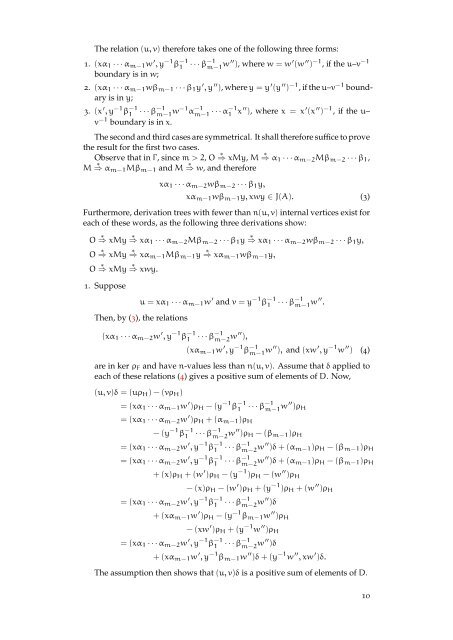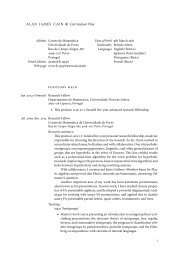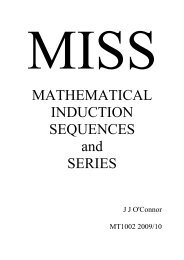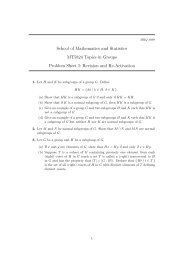Malcev presentations for subsemigroups of direct products of ...
Malcev presentations for subsemigroups of direct products of ...
Malcev presentations for subsemigroups of direct products of ...
Create successful ePaper yourself
Turn your PDF publications into a flip-book with our unique Google optimized e-Paper software.
The relation (u, v) there<strong>for</strong>e takes one <strong>of</strong> the following three <strong>for</strong>ms:. (xα 1 · · · α m−1 w ′ , y −1 β −11 · · · β−1 m−1 w′′ ), where w = w ′ (w ′′ ) −1 , if the u–v −1boundary is in w;. (xα 1 · · · α m−1 wβ m−1 · · · β 1 y ′ , y ′′ ), where y = y ′ (y ′′ ) −1 , if the u–v −1 boundaryis in y;. (x ′ , y −1 β −11 · · · β−1 m−1 w−1 α −1m−1 · · · α−1 1 x′′ ), where x = x ′ (x ′′ ) −1 , if the u–v −1 boundary is in x.The second and third cases are symmetrical. It shall there<strong>for</strong>e suffice to provethe result <strong>for</strong> the first two cases.Observe that in Γ, since m > 2, O ∗ ⇒ xMy, M ∗ ⇒ α 1 · · · α m−2 Mβ m−2 · · · β 1 ,M ∗ ⇒ α m−1 Mβ m−1 and M ∗ ⇒ w, and there<strong>for</strong>exα 1 · · · α m−2 wβ m−2 · · · β 1 y,xα m−1 wβ m−1 y, xwy ∈ J(A).()Furthermore, derivation trees with fewer than n(u, v) internal vertices exist <strong>for</strong>each <strong>of</strong> these words, as the following three derivations show:O ∗ ⇒ xMy ∗ ⇒ xα 1 · · · α m−2 Mβ m−2 · · · β 1 y ∗ ⇒ xα 1 · · · α m−2 wβ m−2 · · · β 1 y,O ∗ ⇒ xMy ∗ ⇒ xα m−1 Mβ m−1 y ∗ ⇒ xα m−1 wβ m−1 y,O ∗ ⇒ xMy ∗ ⇒ xwy.. Supposeu = xα 1 · · · α m−1 w ′ and v = y −1 β −11 · · · β−1 m−1 w′′ .Then, by (), the relations(xα 1 · · · α m−2 w ′ , y −1 β −11 · · · β−1 m−2 w′′ ),(xα m−1 w ′ , y −1 β −1m−1 w′′ ), and (xw ′ , y −1 w ′′ )are in ker ρ F and have n-values less than n(u, v). Assume that δ applied toeach <strong>of</strong> these relations () gives a positive sum <strong>of</strong> elements <strong>of</strong> D. Now,(u, v)δ = (uρ H ) − (vρ H )= (xα 1 · · · α m−1 w ′ )ρ H − (y −1 β −11 · · · β−1 m−1 w′′ )ρ H= (xα 1 · · · α m−2 w ′ )ρ H + (α m−1 )ρ H− (y −1 β −11 · · · β−1 m−2 w′′ )ρ H − (β m−1 )ρ H= (xα 1 · · · α m−2 w ′ , y −1 β −11 · · · β−1 m−2 w′′ )δ + (α m−1 )ρ H − (β m−1 )ρ H= (xα 1 · · · α m−2 w ′ , y −1 β −11 · · · β−1 m−2 w′′ )δ + (α m−1 )ρ H − (β m−1 )ρ H+ (x)ρ H + (w ′ )ρ H − (y −1 )ρ H − (w ′′ )ρ H− (x)ρ H − (w ′ )ρ H + (y −1 )ρ H + (w ′′ )ρ H= (xα 1 · · · α m−2 w ′ , y −1 β −11 · · · β−1 m−2 w′′ )δ+ (xα m−1 w ′ )ρ H − (y −1 β m−1 w ′′ )ρ H− (xw ′ )ρ H + (y −1 w ′′ )ρ H= (xα 1 · · · α m−2 w ′ , y −1 β −11 · · · β−1 m−2 w′′ )δ+ (xα m−1 w ′ , y −1 β m−1 w ′′ )δ + (y −1 w ′′ , xw ′ )δ.The assumption then shows that (u, v)δ is a positive sum <strong>of</strong> elements <strong>of</strong> D.()














